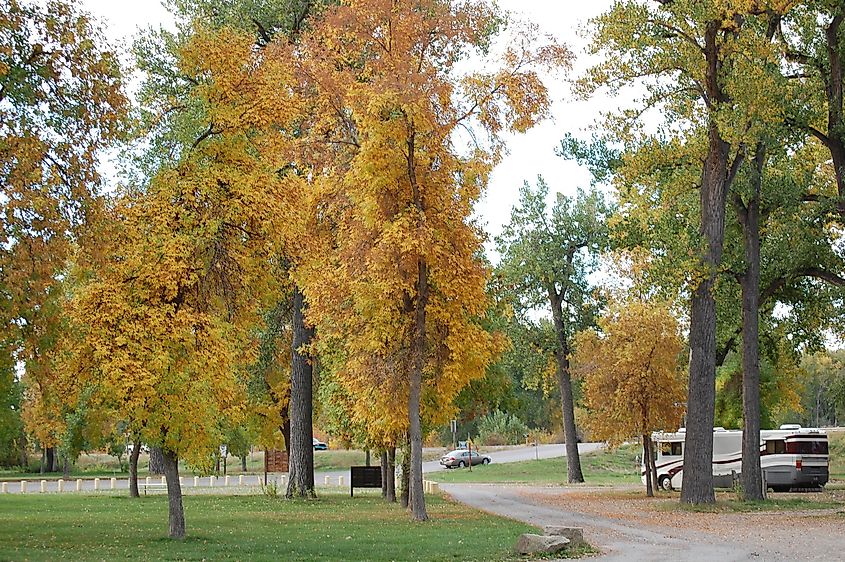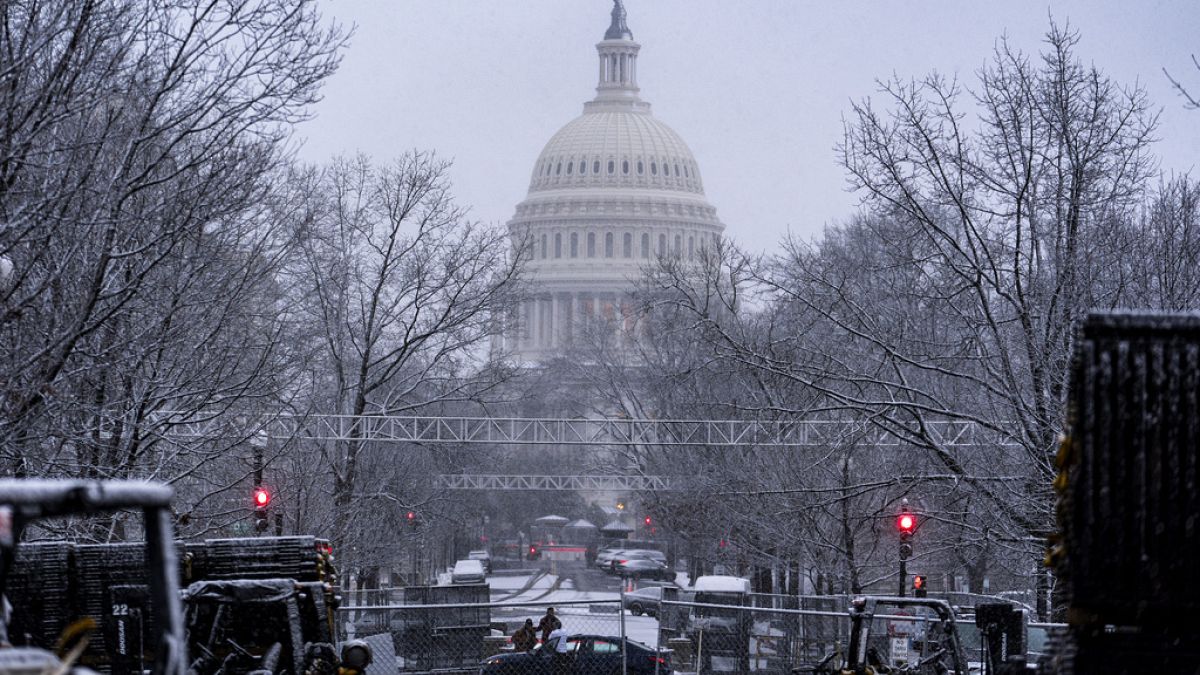Montana
No. 3 Montana State flexes muscles, hammers No. 10 Weber State 40-0

OGDEN, Utah — A top-10 FCS showdown between Montana State and Weber State turned into a showcase for the Bobcats’ defense.
FULL HIGHLIGHTS: NO. 3 MONTANA STATE 40, NO. 10 WEBER STATE 0
No. 3-ranked MSU limited No. 10 Weber State to just 208 yards and only 13 first downs in a 40-0 road blowout at Stewart Stadium on Saturday. With the win, the Bobcats improved their overall record to 3-1 and to 1-0 in the Big Sky Conference.
Analysis: Ben Creighton, Ty Gregorak break down MSU’s 40-0 win over Weber State
Weber State running back Damon Bankston came into the game as the Big Sky’s leading rusher but was kept under wraps to the tune of 36 yards. The Cats held Wildcats’ quarterback Kylan Weisser to 48% passing and 101 yards and sacked him four times.
Showcasing a new offensive look that featured quarterback Sean Chambers taking a high volume of snaps from under center out of an offset I formation, the Bobcats were again efficient moving the football, especially on the ground.
Chambers, with fellow QB Tommy Mellott out again with an injury, was key for MSU again. Chambers accounted for four total touchdowns, two on the ground and two through air to tight end Treyton Pickering.
Turning point: The Bobcats were ahead 13-0 in the second quarter but truly took command when linebacker McCade O’Reilly forced a fumble from Weber State running back Kris Jackson that was recovered by MSU cornerback Jon Johnson at the Weber State 46.
That led to a 29-yard touchdown run by Chambers — his second TD of the first half — and a 20-0 Montana State advantage.
BOBCAT POSTGAME: BRENT VIGEN, PLAYERS DISCUSS 40-0 SHUTOUT OF WEBER STATE
Stat of the game: With the Bobcats, the formula to winning is simple: Run the football. The Bobcats again were dominant on the ground, rolling up 346 yards and averaging 7.7 yards per carry. MSU had four rushing TDs, with Jared White and Elijah Elliott also getting in on the act.
Bobcat game balls: RB Julius Davis (Offense). For a team that has as much running back depth as anyone in the FCS, Davis was the breakout back. The transfer from Wisconsin carried 14 times for 132 yards, an average of 9.4 per rush.
LB McCade O’Reilly (Defense). Plenty of options here, but the junior O’Reilly had perhaps the best game of his career with a team high 11 tackles and a forced fumble. O’Reilly also made a big hit to stop a fake punt attempt by Weber State that immediately led to Pickering’s second TD catch and a 26-0 lead.
What’s next: Montana State returns home to take on Portland State next Saturday at Bobcats Stadium. Kickoff is scheduled for 2 p.m.
The Bobcats have owned their series with the Vikings, having won nine of the past 11 meetings including three in a row. Portland State (2-2, 1-0 Big Sky) comes in having won two straight, including a 59-21 romp over Cal Poly this week.

Montana
Montana Lottery Lucky For Life, Big Sky Bonus results for Jan. 19, 2025
The Montana Lottery offers multiple draw games for those aiming to win big. Here’s a look at Jan. 19, 2025, results for each game:
Winning Lucky For Life numbers from Jan. 19 drawing
08-24-35-43-46, Lucky Ball: 04
Check Lucky For Life payouts and previous drawings here.
Winning Big Sky Bonus numbers from Jan. 19 drawing
06-07-10-12, Bonus: 08
Check Big Sky Bonus payouts and previous drawings here.
Feeling lucky? Explore the latest lottery news & results
When are the Montana Lottery drawings held?
- Powerball: 8:59 p.m. MT on Monday, Wednesday, and Saturday.
- Mega Millions: 9 p.m. MT on Tuesday and Friday.
- Lucky For Life: 8:38 p.m. MT daily.
- Lotto America: 9 p.m. MT on Monday, Wednesday and Saturday.
- Big Sky Bonus: 7:30 p.m. MT daily.
- Powerball Double Play: 8:59 p.m. MT on Monday, Wednesday, and Saturday.
- Montana Cash: 8 p.m. MT on Wednesday and Saturday.
Missed a draw? Peek at the past week’s winning numbers.
Winning lottery numbers are sponsored by Jackpocket, the official digital lottery courier of the USA TODAY Network.
Where can you buy lottery tickets?
Tickets can be purchased in person at gas stations, convenience stores and grocery stores. Some airport terminals may also sell lottery tickets.
You can also order tickets online through Jackpocket, the official digital lottery courier of the USA TODAY Network, in these U.S. states and territories: Arizona, Arkansas, Colorado, Idaho, Maine, Massachusetts, Minnesota, Montana, Nebraska, New Hampshire, New Jersey, New Mexico, New York, Ohio, Oregon, Puerto Rico, Texas, Washington, D.C., and West Virginia. The Jackpocket app allows you to pick your lottery game and numbers, place your order, see your ticket and collect your winnings all using your phone or home computer.
Jackpocket is the official digital lottery courier of the USA TODAY Network. Gannett may earn revenue for audience referrals to Jackpocket services. GAMBLING PROBLEM? CALL 1-800-GAMBLER, Call 877-8-HOPENY/text HOPENY (467369) (NY). 18+ (19+ in NE, 21+ in AZ). Physically present where Jackpocket operates. Jackpocket is not affiliated with any State Lottery. Eligibility Restrictions apply. Void where prohibited. Terms: jackpocket.com/tos.
This results page was generated automatically using information from TinBu and a template written and reviewed by a Great Falls Tribune editor. You can send feedback using this form.
Montana
Bobcats Drop Weber State, Logie Notches 300th Career Win – Montana State University Athletics

OGDEN, Utah – Desperately needing a win, Montana State men’s basketball went on the road and earned one in one of the toughest places to play in the Big Sky Conference, defeating Weber State 70-61 at the Dee Events Center in Ogden, Utah, on Saturday night.
Montana State (7-12, 2-4) had won just ten times in 66 previous trips to see the Wildcats dating back to 1964, but threw the history aside to secure a crucial conference victory.
The result earned head coach Matt Logie his 300th career victory.
“I’m just so happy for these kids, man,” Logie said. “They’ve been through a lot and they’ve stayed together.”
Jed Miller scored a career-high 20 points, going a perfect 12 for 12 at the free throw line and adding six rebounds, two assists, two steals, and no turnovers in 24 minutes off the bench.
“Jed’s earned this,” Logie said. “He’s the epitome of ‘Attitude.’ When he wasn’t playing and getting DNP’s, he had a great attitude, supported his teammates, and learned. He’s a very bright kid in terms of his basketball knowledge, he’s very self-aware, and he works at it. He’s so easy to root for that when the success in practice started to come, you just saw it every day. His assist-to-turnover ratio is always 3-to-1, he understands what we’re trying to accomplish, he makes people around him better, and so I’m really happy for him.”
Miller spearheaded a second-half charge for Montana State as they scored 52 points after halftime on 57.1% shooting from the floor. MSU had struggled in Big Sky play holding onto late leads, but turned it over just twice in the final twenty minutes while going 14 of 16 at the line in the second half.
A big part of that was the play of the junior point guard from Agoura Hills, California, who scored 15 in the second half alone—including a perfect ten of ten at the charity stripe to help ice the game.
“It feels amazing,” Miller told sideline reporter Meghan Robinson postgame. “It’s not just me, it’s our team—this was a great game for us, a great win that hopefully allows us to get some momentum going. When our team plays together, we’re the best offensive team and the best overall team in the conference. Our record does not show what we are capable of right now, and all of us that play for Montana State believe that.”
Miller’s 12 makes at the free throw line tie him with former teammate RaeQuan Battle for the most in a single game without a miss in Bobcat history. Battle also went 12 for 12 against Sacramento State on Jan. 28, 2023.
Entering Saturday having lost seven of their last eight—suffering five defeats by five or fewer points–Montana State changed the starting lineup for the first time this season and shifted a few rotations to try to create a spark.
“I think the best thing that came out of us tweaking the lineup and rotation was the confirmation of our team’s attitude and togetherness,” Logie said. “They really don’t care who starts. We’re trying to find how the puzzle fits the best, and I thought we saw a really good version of Pat McMahon in the second half. That was terrific and we were able to go to him down the stretch. Brandon Walker has continued to make really good decisions with the basketball. He’s growing every game. Max Agbonkpolo has been growing.”
Walker continued his strong stretch of play with 18 points and seven rebounds on 7 of 12 shooting from the floor. Agbonkpolo added 15 points and six rebounds, knocking down three triples and scoring ten in the second half alone.
McMahon also scored ten after halftime, finishing with 12 for the game.
“Despite the fact that we haven’t had results lately, we’ve seen the growth,” Logie said. “The results have been frustrating for sure, but this was a step that we thought could maybe give us a spark. I thought everyone stepped up and made good plays today.”
A physical first half ended with Weber State clinging to a 29-28 lead thanks to a late bucket on the final possession of the frame.
Out of the break, the Bobcat offense found its’ rhythm with a lethal combination of paint touches and efficient outside shooting.
Montana State outscored Weber State 32-22 in the paint, and finished 10 of 22 from beyond the arc for the game.
Just under ten minutes into the second half, the ‘Cats trailed 51-49 before rattling off a 10-0 run to take a 59-51 lead on a McMahon turnaround jumper with 6:33 to play.
MSU then stretched it to a 66-55 advantage on a Miller steal-and-score with 3:59 to go, and never let the margin get closer than seven the rest of the way.
UP NEXT
Montana State will play their third game in five days on Monday, returning to Bozeman to square off with Eastern Washington at Worthington Arena.
The Bobcats will be looking for revenge after falling 68-63 to the Eagles two weeks ago in Cheney on Jan. 4 during the opening weekend of Big Sky play.
Tip is set for 7 p.m.
The game will be streamed on ESPN+, with live radio play-by-play carried on the Bobcat Sports Network.
#GoCatsGo
Montana
8 Best Places To Retire In Montana

Retiring in Montana offers a blend of natural beauty, outdoor activities, and small-town charm that’s hard to beat. Known for its low population density, Montana provides retirees with a peaceful and uncrowded environment. The state boasts relatively low property taxes and no sales tax, making it a financially attractive option. For outdoor enthusiasts, Montana’s pristine lakes, vast national forests, and iconic destinations like Glacier National Park provide endless recreation opportunities. Healthcare access is improving, with high-rated facilities in towns like Whitefish and Billings. Whether it’s fishing on the Yellowstone River, golfing in the Flathead Valley, or enjoying vibrant community events, these eight towns in Montana are some of the best places to retire in the state.
Dillon
If you enjoy small-town life in a place that feels truly safe and comfortable, consider retiring in Dillon. Dillon houses a tight-knit community of less than 4,000 people, fostering a safe and social environment for residents. A retiree here has access to a good university — the University of Montana Western — meaning one can pick a course and enjoy learning during their sunset years. Moreover, the Barrett Hospital and Healthcare has been providing amazing healthcare to residents in the area since 1989. The hospital offers senior life solutions designed to meet the needs of people 65 or older.
To stay fit, one can have a nice little walk along the Beaverhead River with trails such as the Cliff Trailhead. For a more relaxing time out, Clark Canyon Reservoir is a short drive away, perfect for trout fishing and camping. To top it off, Dillon is an affordable destination, with a median home value of $363,000. This is $90,000 less than the state average, so retirees will have lots of cash to spare.
Lewistown

You know a town is the best place to retire when a whopping 27% of its population is above the age of 65. Fitting this criteria, Lewistown offers seniors a robust social environment with plenty of like-minded people. However, aside from its near-perfect social landscape, Lewistown dabbles up as one of the safest towns in the entire state. In short — a retiree here will be at peace.
As to amenities, Lewiston has no shortage. The Lewistown Farmers Market, with its organic goods and crafts, is an excellent place for daily errands. The Central Montana Medical Center has a 24-hour emergency response, so there is no need to make a back-breaking trip out of town, especially if one is under the weather. The other nice thing is that Lewistown’s median listing home price was just $264,000, a steal by Montana standards.
Retirees have plenty of things to do in their free time, such as a stroll through the Lewistown Community Labyrinth Garden, for that one hour of calm and clarity. Or, meet up with your friends to tee off at the 9-hole Pine Meadows Golf Course. Seniors also have immediate access to Big Springs Trout Hatchery & Park, a lovely, well-manicured park with a creek twisting through it.
Whitefish

Whitefish offers natural beauty, outdoor adventure, and top-notch amenities, making it a sought-after yet pricey retirement destination. With a median home listing price of $860,000, it’s on the higher end, but alternatives like The Springs at Whitefish, a senior living community with 24/7 health staff, wellness events, and housekeeping, make life here more accessible. Their two-bedroom residences start at $8,000 monthly, providing a comfortable option for retirees seeking high-quality care. Moreover, healthcare in Whitefish is exceptional, thanks to Logan Health-Whitefish, which received a 5-star overall rating from the Centers for Medicare and Medicaid Services.
For nature lovers, Whitefish is a paradise. Trails abound for hiking and exploring, while Whitefish Lake offers exceptional fishing opportunities. Flathead Lake, the largest natural freshwater lake in the western U.S., is just a short drive away. Meanwhile, Glacier National Park, with one million acres of 700 miles of Rocky Mountain trails and glacial views, promises endless adventures.
Belgrade

Belgrade is a more youthful destination, where only 7% of the locals are senior citizens. However, far from being a downside, many retirees thrive in such social settings. The youthful energy makes it a great place to live with the family, and your grandkids will always want to visit. Visiting Belgrade is also easy as Bozeman is just a blink away, meaning fantastic access to big-city amenities. Additonally, a retiree here has the Bozeman Health Deaconess Hospital, a frequent winner of the America’s 100 Best Hospitals for Pulmonary Care Award.
The Gallatin River flows nearby, an international airport is a heartbeat away, and the immediate scenery is all about beautiful mountains. You will also be a short drive away from Custer-Gallatin National Forest. This two million-acre expanse opens up endless hiking, biking, and camping opportunities amidst landmarks like the Gallatin Mountains and Madison River. No matter how you spend your days, BeeHive Homes Of Belgrade is an assisted-living facility perfect for a good night’s sleep. The facility boasts a warm, residential setting with daily housekeeping, private rooms, and an outdoor courtyard.
Kalispell

Retiring in Kalispell means you will be in the Flathead Valley, one of the most unspoiled and relaxing places to play golf in the entire country. Flathead is one of the 10 best golf retirement destinations. That is according to Golf Digest, the world’s leading golf publication. So, what are your options? There is the Buffalo Hill Golf Course, which boasts one of the best practice facilities in the Pacific Northwest. Another excellent option is Northern Pines, designed by two-time U.S. Open Champion Andy North. Even beyond golf, expect the outdoors here to leave you in awe. You have the Lone Pine State Park, with its scenic overlooks, Flathead Lake, and the jaw-dropping Foy’s Lake Park, a fantastic spot for an afternoon dip.
Worried about amenities? No need. Residents in Kalispell have doorstep access to Logan Health, a 2025 winner of the Outpatient Orthopedic Surgery Excellence Award. The social scene is on-point, considering residents aged 60 and above comprise 18% of the population. While the median home value is a bit high at $540,000, Immanuel Living – Kalispell is an option you may want to consider, especially if your budget is tight. This senior community offers various living options, from quaint apartments at The Terraces to independent patio homes at The Cottages.
Laurel

Few towns can beat Laurel’s Fourth of July fireworks show. But that is just a tiny aspect of the town’s warmth and charm. You will enjoy a small-town feel and access to various shopping options, such as a Walmart Shopping Center for daily needs and AutoZone Auto Parts for vehicle requirements. Best of all, Laurel is less than half an hour from Billings, Montana’s largest city, offering access to endless urban amenities such as the Billings-Logan International Airport. Even with its proximity to Billings, the median home value is just $368,000 a steal compared to Montana’s average of $451,000
Those living in Laurel will find no end to the activities in town. Once in a while, an empty nester can enjoy an afternoon round of golf at the Laurel Golf Club, one of Montana’s finest private golf clubs. Moreover, you can fish at the Lion’s Family Park South Side Pond or enjoy some paddling at Cooney State Park.
Livingston

Livingston is surrounded by beautiful mountain views, ideal for the outdoorsy retiree. Plenty of natural landmarks keep residents on their feet, such as the Yellowstone River and the sprawling beauty of the Custer Gallatin National Forest. Those interested in outdoor adventures can head to Custer Gallatin to attempt challenges such as the Passage Creek Falls Trailhead and Wallace Pass. On the other hand, Chico Hot Springs offers a relaxing alternative for an afternoon plunge.
While all the physical activity should keep you fit, Livingston Healthcare is right in town to cover all healthcare concerns. On the social side, Livingston residents aged 65 and above comprise 20% of the town’s population, meaning you can easily find several folks with whom you can share meaningful experiences. Meeting people is even easier thanks to Frontier Assisted Living, a warm, welcoming environment that operates on the triad of kindness, respect, and support.
Glendive

Glendive, nestled in the heart of Eastern Montana, offers retirees a serene setting with stunning landscapes and a welcoming community. The town is surrounded by natural beauty, including the breathtaking Makoshika State Park, Montana’s largest state park, known for its rugged badlands and unique rock formations. Fishing enthusiasts can enjoy the Yellowstone River, renowned for its trout and catfish, while Hollecker Lake provides a peaceful spot for strolling, relaxing, or people-watching. For a quiet escape, Crisafulli Lake offers a rustic charm perfect for unwinding. Meanwhile, seniors interested in golf will appreciate the scenic Cottonwood Country Club, a local gem ideal for a leisurely game.
Healthcare is a strong point in Glendive, with the Glendive Medical Center serving the community since 1913. This 25-bed acute care hospital provides 24-hour emergency services, along with full medical and surgical care, ensuring retirees have access to quality healthcare close to home. Affordability is another highlight of Glendive, as it boasts the lowest median home price on this list at just $181,000.
The Takeaway
Montana offers retirees a rare combination of breathtaking natural beauty, vibrant communities, and affordable living. From the serene landscapes of Glendive to the active social scene of Lewistown and the outdoor adventures in Whitefish, each town has its unique charm. The state ensures a comfortable retirement lifestyle with low property taxes, no sales tax, and state-of-the-art healthcare facilities. Whether you prefer fishing on pristine lakes, exploring national parks, or finding tranquility in small-town living, Montana truly makes the golden years extraordinary.
-

 Science1 week ago
Science1 week agoMetro will offer free rides in L.A. through Sunday due to fires
-
/cdn.vox-cdn.com/uploads/chorus_asset/file/23935558/acastro_STK103__01.jpg)
/cdn.vox-cdn.com/uploads/chorus_asset/file/23935558/acastro_STK103__01.jpg) Technology1 week ago
Technology1 week agoAmazon Prime will shut down its clothing try-on program
-
/cdn.vox-cdn.com/uploads/chorus_asset/file/25826211/lorealcellbioprint.jpg)
/cdn.vox-cdn.com/uploads/chorus_asset/file/25826211/lorealcellbioprint.jpg) Technology1 week ago
Technology1 week agoL’Oréal’s new skincare gadget told me I should try retinol
-
/cdn.vox-cdn.com/uploads/chorus_asset/file/25832751/2192581677.jpg)
/cdn.vox-cdn.com/uploads/chorus_asset/file/25832751/2192581677.jpg) Technology5 days ago
Technology5 days agoSuper Bowl LIX will stream for free on Tubi
-

 Business6 days ago
Business6 days agoWhy TikTok Users Are Downloading ‘Red Note,’ the Chinese App
-
/cdn.vox-cdn.com/uploads/chorus_asset/file/25835602/Switch_DonkeyKongCountryReturnsHD_scrn_19.png)
/cdn.vox-cdn.com/uploads/chorus_asset/file/25835602/Switch_DonkeyKongCountryReturnsHD_scrn_19.png) Technology3 days ago
Technology3 days agoNintendo omits original Donkey Kong Country Returns team from the remaster’s credits
-

 Politics1 week ago
Politics1 week agoTrump to be sentenced in New York criminal trial
-

 Culture2 days ago
Culture2 days agoAmerican men can’t win Olympic cross-country skiing medals — or can they?








/cdn.vox-cdn.com/uploads/chorus_asset/file/25838949/005NAuPugy1hxqapsuog0j3332222npe__1_.jpg)










